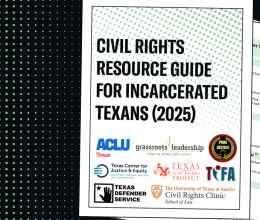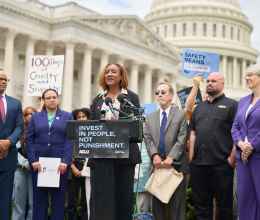
Question: Will the new Standards Protect Inmates from Sexual Abuse in Texas Prisons? Answer: Yes, No, and Maybe
By Kate Vickery
Legislative Intern
On June 20, 2012, the Department of Justice (DOJ) issued its final ruling on national standards to prevent detect, and respond to prison rape, as required by the Prison Rape Elimination Act (PREA), passed in 2003.
If fully implemented, the new regulations will ensure an unprecedented level of protection for prisoners against the epidemic of sexual violence in prison, where one in ten inmates experience at least one incident of sexual victimization. The rate of abuse is significantly higher for women (13%), homosexual males (39%), and homosexual or bisexual females (18%). Unsurprisingly, inmates who are victims of sexual assault are more likely to contract HIV and suffer psychological repercussions.
The new PREA Standards apply to various degrees to state and local prisons/jails, lockups, community confinement facilities, and juvenile facilities.
The standards are over two years behind schedule; the National Prison Rape Elimination Commission presented its draft standards in June of 2009, and the Attorney General was expected to release the final language within a year. The draft standards covered everything from prison layout and construction to immigration detention centers. While the final language was hammered out, with significant public and advocate input, state agencies waited on pins and needles. Brandon Wood of the Texas Commission on Jail Standards said the standards were like the “800 pound gorilla” for many years – no one knew how much change the new rules would require for existing prisons and jails.
Texas has already put a few systems in place to help address the chronic sexual abuse in Texas prisons. In 2007, the 80th Legislature created the PREA Ombudsman program, a semi-external agency (the Ombudsman reports to the Board of Directors, rather than to the Director of TDCJ) that monitors the agency’s efforts to eliminate sexual assaults in TDCJ correctional facilities, ensure the agency's policies and procedures are in compliance with federal and state laws and standards, and respond to public inquiries. The Ombudsman office has a staff of three, who process inmates’ complaints of sexual assault, investigate the allegations, and pass all of them on to the Office of the Inspector General for further investigation.
This system is certainly a step in the right direction, but it is reactive rather than proactive. The new PREA Standards, if fully implemented by TDCJ, should result in fewer instances of sexual abuse in the first place.
The final rules are more watered down than the draft rules, but there are bright spots, particularly for the protections provided to women, youth and LGBTI inmates. As you might expect, the DOJ “has aimed to craft standards that will yield the maximum desired effect while minimizing the financial impact on jurisdictions.” In other words, there is a lot of “should be” and “do your best” language in the final rules, and the enforcement mechanisms lack bite.
Here are a few highlights:
The good: The new standards adopt unprecedented protections for inmates who are lesbian, gay, bisexual, transgender or have intersex conditions (LGBTI) such as using a case-by-case determination for housing assignments for transgender or intersex individuals. In most prisons, inmates are housed according to their “genital status,” the determination of which is done through invasive pat-downs – this will no longer be allowed. Staff will have to have training on effective communication with LGBTI inmates , each of whom will be screened for risk of sexual abuse so that housing, work, education, and program assignments ensure that likely victims are kept away from likely abusers.
According to an extensive 2007 study, transgendered inmates are 13 times more likely to be the victims of sexual assault than other inmates. As you may imagine, LGBTI inmates experience horrifying treatment at the hands of other inmates and prison staff often fail to adequately protect victims from abusers. The ACLU was part of a vocal coalition advocating for these particular protections.
The focus on juvenile facilities should also be commended. The standards require minimum security staffing ratios of 1:8 during waking hours (Texas law currently mandates only a 1:12 inmate-to-staff ratio), for example. The new standards also require that youth housed in adult facilities be separated by “sight and sound” – but not in isolation - from adult inmates, a regulation that echoes State Senator Whitmire’s SB1209, which passed in 2011 and provides similar protections for youth certified as adults. The “sight and sound” separation requirements have caused much consternation among prison administrators, particularly at the county level. Having these requirements codified in the new PREA standards could help ensure that, despite the challenges, prison operators fully comply with SB1209.
Another highlight comes from the standard that requires any facility under contract with the state also to comply with the PREA standards. This could have major ramifications in Texas, where 20 facilities are operated by private contractors who operate with very little transparency.
The bad: The new rules do not apply to immigration detention centers, in which some of the most egregious violations occur, on a national scale. President Obama’s memorandum states that non-DOJ agencies that operate confinement facilities – including DHS – have another year to propose and finalize their own standards. Whether the standards proposed by DHS and other agencies are as comprehensive or informed by advocates and experts remains to be seen. The bottom line is that sexual assault in these facilities have gone under-investigated for too long. Further delay putting protections in place has immediate repercussions for currently detained immigrants.
The uncertain: Will Governor Perry certify the new PREA standards? In a state that frowns on federalism, this remains to be seen. The standards are immediately binding for all federal prisons, but the standards need to be certified by the governor in order to compel TDCJ to implement the changes. Failure to certify the standards would result in a 5% loss of DOJ grant funds although this represents a very small percentage of the criminal justice budget in Texas. The budget impact is most likely not going to be incentive enough.
Assuming the standards are adopted, any accrediting agency that receives federal funding (such as the American Correctional Association, which currently accredits nearly all of TDCJ’s facilities) will adopt the PREA Standards into its accreditation process. This is most likely where the rubber will hit the road for TDCJ, but changes to accreditation standards won’t result in speedy compliance, as each facility applies for re-accreditation only once every three years.
We hope that the Governor will choose to fully certify the PREA standards quickly so that the changes will be made in our prisons and jails sooner rather than later. Sexual violence in our prisons is an epidemic that causes lasting physical and psychological damage to all - adults, youth, men, women, transgender, gay, straight, immigrant and citizen - incarcerated individuals.
For more information, visit the PREA Resource Center. To help reform the criminal justice system in Texas, sign up for the ACLU of Texas Community Action Network.
Related Issues
Related content


ACLU of Texas Responds to State Officials’ Attacks on Nonprofits
November 19, 2025
Why Police Traffic Stops Are Dangerous and Ineffective
October 30, 2025
Advocating for Your Rights Behind Bars: How to Use Our Civil Rights...
August 15, 2025
Texas’ Money Bail System Is Unfair and Ineffective
July 18, 2025
What Is Due Process?
May 28, 2025
ACLU of Texas, Civil Rights Groups Send Letter to Texas Lawmakers...
May 23, 2025
ACLU of Texas Comments on Passage of S.B. 9 — Bail Bill That...
May 19, 2025